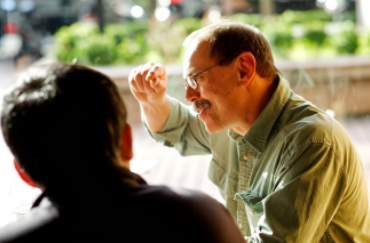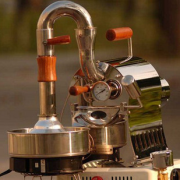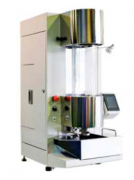Introduction to the roasting of fine coffee Diedrich coffee roaster
StephenDiedrich is the founder and president of the American Diedrich coffee roaster manufacturing company. Taking advantage of the opportunity that Viti invited him to Taiwan to participate in the coffee exhibition, Coffeet&i magazine conducted an in-depth interview with him for more than two hours on November 25th. Stephen talked eloquently about his entrepreneurial process, the concept of designing the roaster and the mental journey of development, and also gave some suggestions to coffee people in Asia.
At 2: 00 p.m. on November 26th, Stephen held a coffee roasting lecture at Viti, the general agent in Taiwan. Stephen told me in advance that he would share a lot of their baking ideas and techniques, but it was not until he participated in the lecture that he realized that Stephen brought a solid course, which lasted for more than four hours, ranging from the design concept of the roaster to the creation, testing and application of baking curves (RoastProfile). It was explained very clearly.

The reason why Diedrich uses infrared heater: using clean air to bake, good energy conversion efficiency, health, environmental protection, stability.
Stephen's father, Carl, designed and manufactured coffee roasters as early as the 1960s. The early models had a water curtain dust collection design. By observing the roasting exhaust, Stephen made the water very buried, making Stephen feel that traditional open fire roasting was like roasting coffee beans with car exhaust, so he came up with an improved way to use infrared heaters.
The design concept of the heat exchanger is inspired by Stephen engaged in aircraft maintenance and German Audi and Porsche automobile machinery maintenance. The air-cooled design of the aircraft engine is "anti-designed" to make it the receptor of infrared radiation heat, and then heat the clean ambient air to bake coffee beans.
Characteristics of traditional open fire burner: the main heat source comes from heated air and the secondary heat source is radiation. The temperature of hot air is not easy to be stable and is directly affected by airflow intensity and firepower intensity.
Characteristics of infrared heater: the main heat source is radiant heat and the secondary heat source is convective heat. The temperature of the hot air remains stable.
The first explosion temperature of the Diedrich roaster is constant at 197C, while the second explosion temperature varies according to the structural density of beans.
Stephen personally suggested that the baking temperature be measured in "Fahrenheit", because the Fahrenheit measurement is finer than Celsius, it is easier to observe and record, and there are more subtle differences, so every time you write down the temperature in the baking record, you should immediately do a simple mathematical calculation to calculate the extent of the temperature rise (warming ratio) and observe its change.
Stephen recommends that the QC cup be tested "immediately" after baking, even if you can only drink 20 to 30% of the cooked taste, because you can immediately adjust and re-bake according to the test results to achieve the best baking curve.
The higher the moisture content of raw beans, the sweeter the baking result.
The weight loss ratio of Stephen's preferred baking is between 13.5% and 15%, and that of deep baking is more than 18%. He personally does not like baking results with a weightlessness ratio of 15 to 17%, because this degree loses sweetness and begins to lose other advantages, but he has not yet got enough deep-baked smell, so it is better to get deep-baked smell directly.
The weight of coffee beans before and after roasting should be measured in each oven and the weight loss ratio should be calculated.
When you find that the weightlessness ratio becomes higher, it may be:
1. Your baking time is getting longer.
two。 Your baking degree is getting deeper.
3. Your airflow (throttle setting) is stronger than before.
When you find that the weightlessness ratio becomes lower, it may be:
1. Your baking time is getting shorter.
two。 Your baking degree is getting shallow.
3. Your airflow (throttle setting) is weaker than before.
The heat source of the Diedrich roaster is designed to be 70% convective heat, 30% heat transfer is controlled by air flow, and the roaster can control the ratio of convection heat to conduction heat.
When your exhaust line is blocked by careless cleaning, it weakens the air flow and reduces convective heat, and you have to increase your firepower in order to maintain the best curve, which leads to an increase in the use of conduction heat, which eventually leads to different baking results.
Stephen believes that good baking curves are mostly S-like or inverted M-shaped, not straight (James added: in the case of American baking, this is true. Not in terms of other baking cultures.)
What the baker needs to do: 1. Test the best curve of each bean 2. Try to reproduce the best curve when baking.
There are five steps to developing a baking curve:
1. Determine the baking depth
two。 Determine the "best time" to reach this baking depth
3. Develop an ideal temperature rise slope
4. Based on the results of the previous steps, a suitable airflow setting is developed.
5. Re-detect the heating curve according to the air flow setting result of the previous step
6. Re-check whether the setting of baking depth needs to be adjusted according to all the above variable settings.
What you should do when baking is to "follow" your best curve and try to keep up with it all the time, not "record". You don't have time to take notes when following and reproducing the curve.
The best curve should be updated at least three to four times a year, and should be retested as long as the raw bean batch is different.
Always keep the roaster and pipes clean. If they are not clean, the baking curve you develop is completely useless.
Stephen recommends that you decide the time to come out according to the color, constantly pull out the sampling stick and observe it over and over again, and take samples once or twice after reaching the set color, to make sure that the color is what you want, and before the beans are changed to another color, open the oven door to let the beans out. The above process is completed in 10 seconds.
If you let the beans out of the oven as soon as you see the color, it will easily cause your baking to become lighter and lighter before you know it.
Coffee roasting has always lacked advanced and open courses and information, not to mention the first-hand information from the founder and president of the world-famous coffee roaster factory, which shows the precious value and hard-won value of this lecture. Although what he studies and is good at is American baking, which is very different from the Nordic roasting that I am good at, through such a rich lecture, more people can understand the details of roasting and realize that good coffee is not easy to be roasted. I believe that such sharing will be like a stone thrown into the pool, and the ripples will gradually spread, making the coffee world more progressive. -James
Important Notice :
前街咖啡 FrontStreet Coffee has moved to new addredd:
FrontStreet Coffee Address: 315,Donghua East Road,GuangZhou
Tel:020 38364473
- Prev

Introduction to coffee roasting Taiwan Hook huky500 coffee roaster
Taiwan Huky500 is one of the best-selling small and medium-sized roasters recently, with excellent design structure, which allows users to choose baking in both direct and semi-direct fire modes. You can bake up to 500g at a time so that you can bake half a pound of excellent coffee beans at a time! The most important thing is the price advantage [about 10000 yuan], which is very attractive and easy to operate for coffee shops or coffee players.
- Next

Coffee maker recommends commercial hot air roaster Fluid Bed Shop Roaster
The all-electric hot air roaster has the advantages of simple use, convenient maintenance and stable production for all bakers. The 2.5-kilogram roaster targets coffee shops, hotels and retailers. Because these users need to consider various factors such as price, product quality, productivity, brand and maintenance simplicity. This roaster is designed as a workbench. In heat resistance
Related
- What is the Philharmonic pressure? How to use Philharmonic pressure to make delicious coffee
- Why does a hand grinder have more fine powder than an electric grinder?
- In addition to the hot mom, what is the difference between the versions of EK43 | ditting and Mahdi ek43?
- What kind of equipment do you need to make coffee by hand? Introduction to novice starter cooking equipment tools
- Espresso needs to be ground how thick and thin scale entry Italian Coffee Machine Bean Grinder investigation and Grinding course
- How much does it cost to open a small private cafe? How much does it cost to learn coffee? How to operate it?
- The difference between the flavor characteristics of hand-brewed coffee and coffee maker is hand-brewed coffee really better than coffee maker? Can I use a coffee machine to make coffee beans by hand?
- The difference between 01 and 02 of hario v60 filter cup what is the difference between 01 and 02 filter cup opening and cooking flavor
- What's the difference between the smart cup and the French kettle? Which is better, the French kettle or the Smart Cup?
- What's the difference between a smart cup and a V60 filter cup? The difference between the taste of smart cup and hand-brewed coffee

